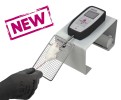Authors
E. J. Mientjes, R. Willemsen, L. L. Kirkpatrick, I. M. Nieuwenhuizen, M. Hoogeveen-Westerveld et al.
Lab
Erasmus University, Department of Clinical Genetics and Department of Pathology, Rotterdam, The Netherlands ; Baylor College of Medicine, Department of Molecular and Human Genetics, Houston, USA ; CNRS/INSERM/ULP, Institut de Genetique et de Biologie Mole
Journal
Human Molecular Genetics
Abstract
FXR1 is one of the two known homologues of FMR1. FXR1 shares a high degree of sequence homology with FMR1 and also encodes two KH domains and an RGG domain, conferring RNA-binding capabilities. In comparison with FMRP, very little is known about the function of FXR1P in vivo. Mouse knockout (KO) models exist for both Fmr1 and Fxr2. To study the function of Fxr1 in vivo, we generated an Fxr1 KO mouse model. Homozygous Fxr1 KO neonates die shortly after birth most likely due to cardiac or respiratory failure. Histochemical analyses carried out on both skeletal and cardiac muscles show a disruption of cellular architecture and structure in E19 Fxr1 neonates compared with wild-type (WT) littermates. In WT E19 skeletal and cardiac muscles, Fxr1p is localized to the costameric regions within the muscles. In E19 Fxr1 KO littermates, in addition to the absence of Fxr1p, costameric proteins vinculin, dystrophin and _-actinin were found to be delocalized. A second mouse model (Fxr1+neo), which expresses strongly reduced levels of Fxr1p relative to WT littermates, does not display the neonatal lethal phenotype seen in the Fxr1 KOs but does display a strongly reduced limb musculature and has a reduced life span of _18 weeks. The results presented here point towards a role for Fxr1p in muscle mRNA transport/translation control similar to that seen for Fmrp in neuronal cells.
BIOSEB Instruments Used:
Grip strength test (BIO-GS3)

 Douleur - Allodynie/Hyperalgésie Thermique
Douleur - Allodynie/Hyperalgésie Thermique Douleur - Spontanée - Déficit de Posture
Douleur - Spontanée - Déficit de Posture Douleur - Allodynie/Hyperalgésie Mécanique
Douleur - Allodynie/Hyperalgésie Mécanique Apprentissage/Mémoire - Attention - Addiction
Apprentissage/Mémoire - Attention - Addiction Physiologie & Recherche Respiratoire
Physiologie & Recherche Respiratoire
 Douleur
Douleur Métabolisme
Métabolisme Système moteur
Système moteur Neurodégénérescence
Neurodégénérescence Thématiques transversales
Thématiques transversales Système musculaire
Système musculaire Functions de motricité générale
Functions de motricité générale Troubles de l'humeur
Troubles de l'humeur Other disorders
Other disorders Joints
Joints Système Nerveux Central (SNC)
Système Nerveux Central (SNC)  Système sensoriel
Système sensoriel
